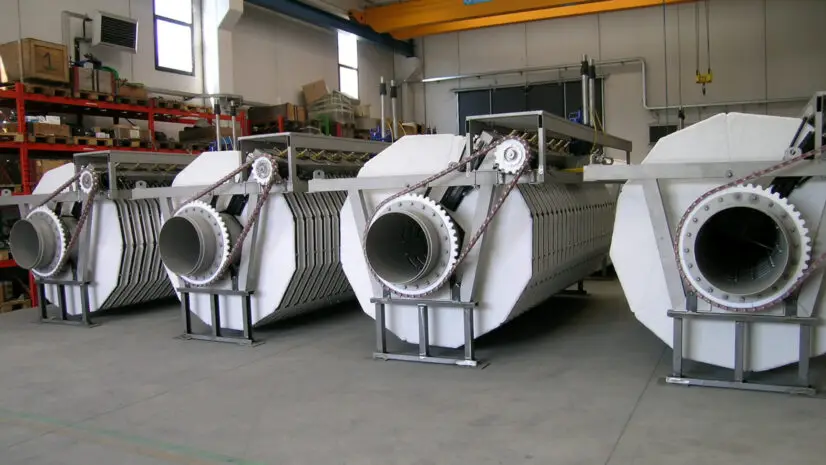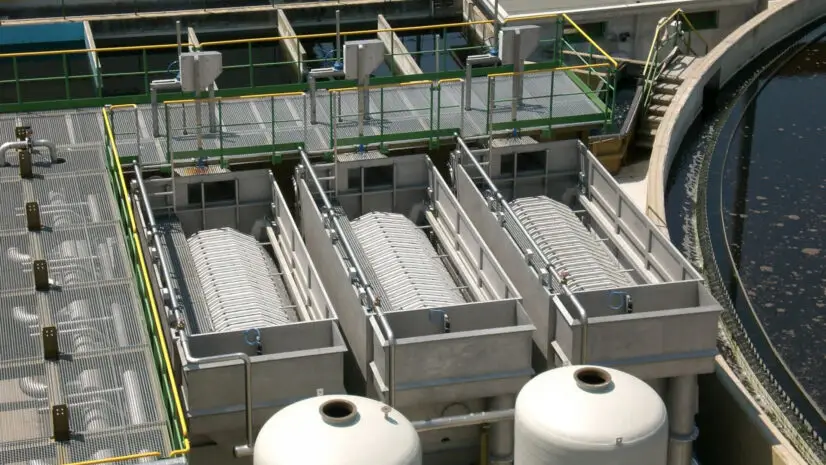Pile Cloth Filters for Wastewater Treatment: an Overview

If you’ve come to this guide, it’s probably because you’re interested in tertiary filtration of civil wastewater or industrial process effluent finishing. And you’ve probably heard of this technology: pile cloth filters for water treatment. What are they? How do they work? At what stage of purification do they intervene or with what benefit?
Tertiary filtration solutions can be divided, based on the type of filter media used, into two macro-categories: micro-screen filters (they use monofilament nets) and free-fiber cloth filters (they exploit the properties of free-fiber cloth). These technologies have some similarities and can effectively remove suspended solids.
Why then, in many circumstances, is it preferable to install a pile cloth filter system for wastewater treatment? We will find out together in this article.
1. Cloth filters for water treatment
Cloth filters are an effective method of removing impurities and solid particles from water, ensuring its clarity and safety.
They are normally employed in tertiary water filtration, or “final filtration,” and make it possible to reduce the suspended solids content of water by tens of mg/l to virtually zero.
Currently, there are two types of filters used for tertiary water treatment:
- Micro-screen cloth filters: the filter medium is two-dimensional and consists of a weave of synthetic or metallic threads, the passage light of which determines the filtering capacity.
- Pile cloth (or free-fiber) filters: the filter cloth is three-dimensional and consists of a basic weave to which synthetic free fibers are attached, providing a more selective equivalent degree of filtration than the weave mesh.
If we wished then to provide a definition of cloth filters: they are water treatment systems that allow a reduction of suspended solids down to a few mgSST/l by exploiting a free-fiber cloth as a filter medium.
In general, we can list a number of advantages provided by cloth filters in water treatment:
- Removal efficiency of suspended particles: cloth filters are able to remove fine particles (< 10 microns) due to the action of the filter cloth.
- Continuous filtration: there is no need to install backup units; filtration does not stop during the automatic backwash cycle of the cloths.
- Flexibility in case of overloads at the filter inlet.
- Low installation costs: generally, tertiary filtration systems with filter cloth are an advantageous initial cost solution due to extremely low ancillary works.
- Ease of cleaning and maintenance: most cloth filters are easy to clean and maintain, which reduces operating costs.
2. Pile cloth filters for water treatment: operation
Pile cloth filters are one of the most efficient systems for tertiary water treatment.
These cloth filters for water treatment stand out as an efficient and versatile solution for tertiary filtration. Their great effectiveness lies in combining the advantages of surface filtration, typical of micro-mesh filters, with the depth filtration of sand filters, offering high suspended solids removal (SST) capacity at low cost.
The support structure of the synthetic-fiber filter cloth consists of discs or a drum. Wastewater is gravity-fed through the cloth, and the interwoven fibers that make up the cloth trap suspended solids particles of varying sizes on its outside. Treated water is conveyed inside the filter elements and reaches the hollow central axis, while solids that settle on the cloth are periodically removed from the system by the automatic backwash device.

The filtration mechanism is based on two basic principles.
- Depth filtration: the loose fibers of the fleece create an intricate maze of irregular passages, resulting in a thick layer of filter material. This design causes SST particles to penetrate between the fibers and become trapped between them. Depth filtration ensures more efficient removal of solids, even the finest micron-order solids.
- Out-in flow of wastewater: water to be treated enters the filter housing tank, passes through the filter discs or drum, and flows to the central shaft. Solids intercepted by the filter remain outside the filter, avoiding clogging the internal passages of the machine and making cleaning simple and effective.
Fleece filters can effectively remove a wide variety of suspended solids, down to concentrations of less than 10 mg/l in the outlet water. This also makes them suitable for treating wastewater or process water from a variety of industries, such as the textile, paper, food and chemical industries.
Ask for Information3. Pile and micro-screen filters: similarities and differences
Pile cloth filters and micro-screen filters: two solutions are united by their use for advanced water treatment, but each is characterized by structural specificities.
In both systems, water passes through a filter media that traps the suspended solid particles present. Solids intercepted by the filter are periodically removed by a backwash system.
On the other hand, it is clear how the structural difference in filtering media translates into significant differences in functionality. Let’s look at them.
- In the case of pile cloth filters, the filtering medium consists of a mass of free synthetic fibers, attached to a supporting framework, which provide depth filtration. In contrast, in micro-screen filters, the filtering medium consists of a two-dimensional metal or synthetic screen, whose passage light determines the filtering capacity, resulting in surface filtration.
- Differences can also be found in the washing system of the filter medium: this is done by suction (backwashing) for pile cloth filters, with pressurized water in the case of micro-screen filters.
- The direction of filtration is also different: from the discs (or drum) to the central shaft in the case of fleece filters (out-in), from the shaft to the discs in micro-net filters (in-out). In general, gravity filtration of free-fiber filters results in greater energy savings, as pressurization pumps are not required.
- Finally, the quality of the water to be treated: micro-net filters are more suitable for water with low concentrations of SST, while fleece filters can also handle water with high concentrations of SST.
4. Disc and drum cloth filters: differences
Let us first make a premise: let us differentiate between “rotating disk filters” and “disc filtration systems”.
The premise is necessary because many users, still unaware of water treatment issues (especially in industrial settings), search for the two terms and discover systems that are very different in structure and especially in use.

On the one hand, we have rotating disk filters: tertiary-level water treatment systems (in the civil sector) or for wastewater finishing (in the industrial sector). These systems mount disks on a hollow shaft and use a cloth, often fleece, as a filter medium for suspended solids and phosphorus. On the other hand, we have so-called “disc filtration systems”: irrigation solutions that have nothing to do with wastewater treatment.
We have therefore provided a definition of rotating disk filters. To avoid confusion, however, it is best to refer to these systems as “cloth-on-disc filters” or again “disc filters for wastewater treatment.” Recalling, as we have already seen, that these systems can be equipped with micro-nets (for surface treatment) or free-fiber fleece (for depth filtration, similar to sand filtration).
Can pile cloth filters be solely on rotating disks? Not at all. As mentioned above, there are also drum pile cloth filters: the filter cloth is mounted on a cylindrical support structure.
So, which of the two solutions should be preferred?
Broadly speaking, disk filters for water treatment are generally more suitable for treating large volumes of water because they offer a larger filtration surface area. Drum filters are appreciated where there are limited flow rates to be treated and, in particular, where installation space is limited.
Find MITA Pile Cloth Filters5. Pile cloth filters: the backwash phase
Backwashing of filter cloths is an important operation that is performed automatically on fleece filters to maintain the efficiency of the filtration process.
It is natural that, during filtration, solid particles gradually accumulate on the cloth, reducing the system’s treatment capacity. Backwashing helps to remove these particles and restore the efficiency of the filtration process.
Backwashing is performed at regular time intervals or when pressure drops increase to a threshold value. The process involves reversing the flow of water through the cloth to remove particles accumulated on the surface of the fabric. The water used for backwashing is recirculated at the head of the system through a dedicated line, so that the particles removed from the cloth are removed from the filter system.
It is important to know that, during this stage of filter cloth cleaning, the filter cloth system continues to operate: a point in favor of the operational continuity of the machinery and, in general, of the civil or industrial treatment plant.
6. Pile cloth filters for municipal and industrial water
To conclude, let’s talk about concrete applications: can pile cloth filters be used to treat both municipal and industrial wastewater?
Certainly: both applications are possible and widely referenced. Of course, the choice of filter type depends on the specific characteristics of the water and the requirements of the treatment process.
In the case of municipal wastewater, pile cloth filters are used as a tertiary stage of purification, with the goal of targeting stringent regulatory limits that allow, for example, irrigation reuse of the water. Secondly, a tertiary filtration section allows optimizing the performance and management of downstream treatment sections such as, for example, UV disinfection.
In the case of industrial wastewater, on the other hand, “industrial” fleece filters can be used as a water finisher either in the case of discharge to the sewer or with a view to allowing internal reuse. As in other cases, it is important to emphasize how heterogeneous production realities present wastewater in terms of quality and quantity of pollutants: before any final installation, it is important to test the applicability of the filtration process through a pilot unit.
Ask for InformationResources
Needs of wastewater treatment
Discover the solution for all needsComparing different technologies
Find out all the different technologiesFind out more
All technical articlesOur Newsletter
Sign up for the MITA Water Technologies newsletter: stay up-to-date on systems for municipal and industrial wastewater treatment and filtration.